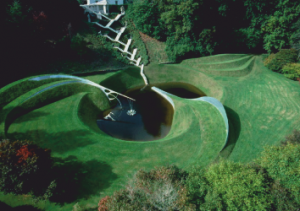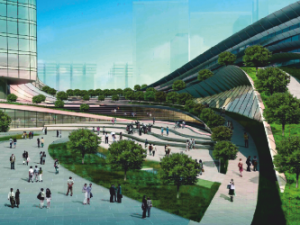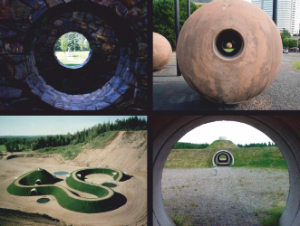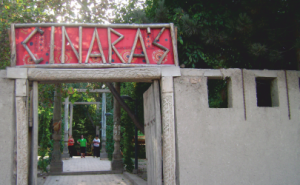Marina Borodina,
Artist
Creating theme parks and green space has become relevant for modern-day urban landscape design. Residential area landscaping is no longer considered only as “greening”, but creating thematic micro-landscapes representing the “face” of the city as well.
 Landscape design is intended to address comprehensive human habitat organization, thus going beyond traditional methods of park and garden landscape arrangement. This orientation is defined by the wider range of challenges facing designers at the junction of urban planning and artistic environment setup domains to come up with “meditative” recreations.
Landscape design is intended to address comprehensive human habitat organization, thus going beyond traditional methods of park and garden landscape arrangement. This orientation is defined by the wider range of challenges facing designers at the junction of urban planning and artistic environment setup domains to come up with “meditative” recreations.
Each party involved in landscape design – be it an architect, sculptor, dendrologist, environmentalist, builder, or engineer – finds support in the history of park and garden landscaping art and the knowledge in the field of ecology, dendrology, botany, hydrology, soil science, site engineering, and other components.
In this regard, important is the author’s field of vision and his awareness of many related disciplines; also essential is a concentrated effort that determines the end result of integrated design: aesthetic, functional, environmental, commercial, structural, or philosophical and ideological solutions to the formulated problems. The emphasis in the design is placed on creating vivid spaces defining the individuality of the site.
 Landscape scenarios can be conventionally divided into the following groups: cognitive, aesthetic, sports-related, environmental, educational, economic, and recreational. Of these, the most relevant are the following concepts:
Landscape scenarios can be conventionally divided into the following groups: cognitive, aesthetic, sports-related, environmental, educational, economic, and recreational. Of these, the most relevant are the following concepts:
Nature Enshrined. Holding vegetation sacred, recognizing cosmic order divinity, searching for organic interface between buildings and nature, nature and man, and worshiping the mystery of nature’s laws are the fundamental principles.
Landscape Aestheticized. One of the most important objectives of contemporary design art “science” is to optimize society-nature relationships for both to co-evolve and develop harmoniously. Cultural landscape is a term that refers to any geo-system that in both its appearance and inner structure shows the presence and transforming activity of man representing a particular culture. Following this logic, a dump, for instance, is also a cultural landscape. This example is particularly illustrative of human activity that transforms the nature’s frame.
Ideas formulated by Academician Vladimir Vernadsky about the biosphere evolving into the noosphere – the domain of cognition, also relate strongly to the concept of aestheticizing cultural landscape. Specifically, the intellectual energy he wrote about that drives noosphere development has many analogies in the notions about a spiritual component in the cultural landscape. The heyday of the classical period in the landscape aesthetization concept evolution – the Renaissance followed by the period of absolute monarchies in Europe – manifested itself in the classic examples of park and garden landscaping art.
 Environmental landscape design concept represents a set of measures to protect the natural landscape from pollution and destruction, an advocacy for clean natural element, and creation of human-friendly artificial environment.
Environmental landscape design concept represents a set of measures to protect the natural landscape from pollution and destruction, an advocacy for clean natural element, and creation of human-friendly artificial environment.
Nature Symbolized. This concept involves the quality of architectural forms placed in the natural environment to align with natural shapes and follow the principles of interpretation of nature. City represents a particular form in which nature exists: not its antipode but an interpreter. One example is the Garden of Cosmic Speculation created by Charles Jencks, the renowned architect, critic and theorist of postmodernism. For a number of years now this truly amazing cosmic garden, despite cabbage beds and the long name, has been regarded as one of the most original gardens on the planet. It is located near Dumfries in South West Scotland, spanning across an area of 12 hectares. The garden with its flowing, curved terrain, as if on a Chinese miniature, provokes contemplation of the cosmos, the origin of the Universe, and the meaning of life. Whenever a visitor is tired of this kind of “brainstorming”, he can relax in the gazebo of meaninglessness where nothing gets in the way of relaxing and staying alone with one’s thoughts (Pic. 1-2).
Nature Compensated stands for the making up for inflicted damage, the “compensation” landscape. Geo-equivalence – the matching of the manmade cultural landscape to the natural one that existed in its place – is achieved through the following devices: area reproduction (roof gardens, vertical faсade greening), underground architecture, etc. (Pic. 3)
Compensation Landscape Example
Spatial illusions are the devices for visual expansion or deepening of space, an intention to show an architectural object on a harmonious background, or to accentuate natural elements in today’s confined urban environment. The authors of modern landscape design perform an act of creation, connecting it with nature, and employ every opportunity to emphasize its ecological essence on the level of symbols, visual preferences, and optical effects.
When creating a particular landscape scenario in a project site, the designer uses a set of modern conceptual devices. These include, for example, fencing the area with reflective surfaces (mirrors), alternating transparent and blind sections depending on the wish to expose the garden space (“Yard without Borders” scenario) or conceal the unwanted sight and create a chamber enclosure (“Monastic Yard” scenario).
Intention to surprise is inherently present in the art of design. Design is governed by the basic conceptual idea behind the project. Ideology behind Land Art as a trend is intended to generate the most striking projects. The lack of space and over-saturation of contemporary urban environment result in the emergence of artificial control over the observer’s “gaze” and of the space visual correction devices, such as point of view (vista) fixation, concealment of undesirable components of the view, accentuation of natural elements, optical illusions, etc.
Vista Device
 Many contemporary landscape designers see relevance in creating vista – fixed observation points where the eye is guided by alleys, colonnades, corridors, or frames, at the end or inside which the viewer can see the benchmark, the emphasis, or the picture snatched from chaos… Designer Dani Karavan in his White Square project in Tel Aviv created geometric shapes of concrete, cut through by vistas: views on the Tree, the Sea and the Mountains. He named his work “Road of the Sun” (Pic. 4a). The same principle was followed to build the “Way of Light” (Pic. 4b).
Many contemporary landscape designers see relevance in creating vista – fixed observation points where the eye is guided by alleys, colonnades, corridors, or frames, at the end or inside which the viewer can see the benchmark, the emphasis, or the picture snatched from chaos… Designer Dani Karavan in his White Square project in Tel Aviv created geometric shapes of concrete, cut through by vistas: views on the Tree, the Sea and the Mountains. He named his work “Road of the Sun” (Pic. 4a). The same principle was followed to build the “Way of Light” (Pic. 4b).
Vista. D. Karavan. “Road of the Sun” (a) and “Way of Light” (b) projects.
Vista. Nancy Holt (USA). 2000 Vistas in Dark Star Park, Finland.
One example of such techniques of conceptualizing space and creating a scenario or a theme into which the visitor is introduced like in a drama show, with the natural landscape preserved as a decorative background, is a recently built landscape-recreational complex called The Chinars [Sycamore Trees] in the Bostanlik District of the Tashkent Province of Uzbekistan, where one can clearly see the implemented synergetic principle in conceptualizing modern theory and practice of landscape design in terms of coexistence of things natural and artificial. Not only this example paves the way to design-engineering, but also suggests methods of sound landscape management, taking into account the phenomenon of self-organization in it.
Views of The Chinars park (Tashkent Province) built under a shady canopy of 600-year-old plane trees.
Apparently, those who conceived and sponsored this environmental setup were driven by a rather simple idea: to offer people an outdoor comfort comparable to one at home – with a lounge, sofas and tables, creative lighting and small water inclusions inhabited with life.
The use of landscape surface as a natural “carpet” to continue the hospitality theme that runs from the entrance gate has become the key element in enhancing aesthetics of the environment, contributing to its sustainable utilization and conservation.
It has to be noted that in the developed countries the current interest in organizing natural environment around major cities manifests itself not just in investment, but increasingly in the promotion of new approaches to the interpretation of modern recreations of urban and suburban space that supports ecology and aesthetic of the nation’s culture. Green technology expands urban living space, filling it with nature and removing visual barriers in the shape of monumental fences of wrought metal.
References
1. Вергунов А. П., Денисов М. Ф., Ожегов С. С. Ландшафтное проектирование. М., 1991.
2. Дормидонтова В. В. История садово-парковых стилей. М., 2003.
3. Забелина Е. В. Поиск новых форм в ландшафтной архитектуре. М., 2005.
4. Квасов А. Ф. Ландшафтная архитектура: специальность или метод? Архитектура, строительство, дизайн. 1996.
5. Квасов А. Ф., Ожерельева М.В., Судаков М.И., Топунов А.И. Архитектурная дендрология. М., 2007.
6. Нефедов В. А. Ландшафтное проектирование. Спб., 1996.
7. Ожегов С. С. История ландшафтной архитектуры. М., 1994.
8. Ожегова Е. С. Ландшафтная архитектура. История стилей. М., 2009.
